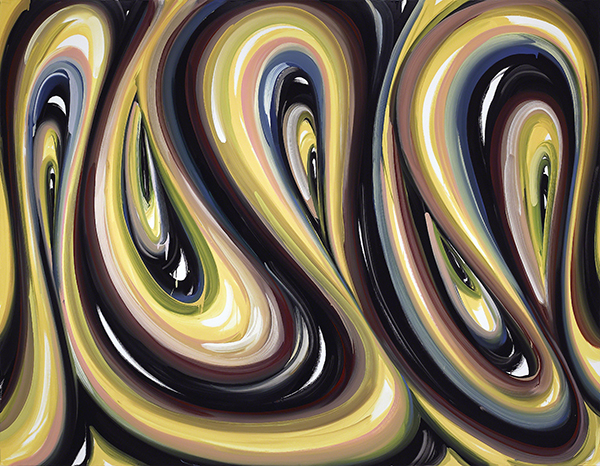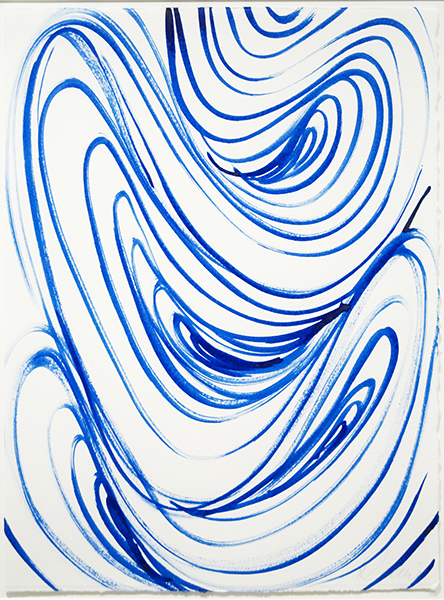Women's History Month 2022: Karin Davie
Karin Davie is a Canadian artist who has explored traditional elements of art in a completely novel manner. Her emphasis on the action of line could put her work into the realm of Process Art, although her color is much too luscious to reduce it to that term. With the sense of push and pull in her works (remember Hans Hofmann’s theories about creating the illusion of depth in non-objective abstraction?), how about the term “Neo-Illusionism”? Whatever art historians want to call it, Davie’s work is FABULOUS.
 |
| Karin Davie (born 1965, Canada), Pushed, Pulled, Depleted, & Duplicated #7, 2002–2003. Oil on canvas, 7’ x 9’ (213.4 x 274.3 cm). Courtesy of the Albright-Knox Art Gallery, Buffalo, NY. © 2022 Karin Davie. (AK-1295) |
Davie's Pushed, Pulled, Depleted & Duplicated series of paintings are a graphic display of her reinvigoration of the stripe, which she feels had been devalued in the language of art during the Modernism period of the late 1900s. In these works, she aspires to endow the stripe with a representational meaning, using the gestures of her body in creating the work to reinterpret the idea of "gestural painting."
In these artworks, Davie activates something between the canvas and the viewer, exciting the viewer's perception of the movement of the brushstrokes, and, ultimately, her body across the surface during the painting process. She rejects comparisons with Bridget Riley's (born 1931) Op Art, in which line creates the illusion of depth through mathematics. However, Davie's work does create the illusion of depth in a stridently two-dimensional technique using color as well as variation of line thickness.
The word most used for art during the period of the early 2000s has been "global." With the collapse of most boundaries and ideological agendas (with a few exceptions), artists are free in the 2000s to explore ideas and subject matter that are relevant to people on many different levels, including political, cultural, environmental, and material. These concerns often combine in various ways to support either an artist’s world view, an aesthetic viewpoint, or both. Such rethinking of art has been around since the period of Dada and Surrealism (ca. 1915–1930s), when the very idea of art itself was questioned.
The question in contemporary art is no longer "what is art?" but rather "how does the creative process reflect what the artist is trying to say?" Since Surrealism of the early 1900s, and the experiment of art in the 1960s and 1970s, there are also no longer boundaries between the various forms of expression in art. Sculpture and painting merge with performance, architecture merges with sculpture, fiber art merges with painting, and materials once considered "support" have become the medium.
Davie actively explores the reinvigoration of certain aspects of abstract painting that have become stale in the 2000s. She has hit upon the combination of the gestural emphasis of Abstract Expressionism—think Willem de Kooning (1904–1997)—with the reinterpretation of the line, an element of art that had become codified in Minimalism—think Kenneth Noland (1924–2010).
Born in Toronto, Canada, Davie aspired to be a dancer as a young child. Not relishing the public scrutiny of performing, she longed for an equally fulfilling creative outlet. She settled on painting at 8 years old after seeing an exhibit of Color Field painting at the National Gallery of Ontario. One artist who inspired her was Morris Louis (1912–1962), whose work is often characterized by long dripping stripes of pure color next to one another. Another was Barnett Newman (1905–1970), whose work features long, usually vertical bands of pure color side by side.
Davie earned a BFA from Queen's University at Kingston in Toronto (1987) and an MFA from the Rhode Island School of Design (1989). It was at Queen's University that she was exposed to the NeoGeo movement. NeoGeo was a movement evolving in the 1980s that focused on objects or emotions of the physical world expressed in a more potent (expressive) geometric abstraction than the sterile Minimalism of the 1970s.
 |
| Karin Davie, Pushed, Pulled, Depleted & Duplicated Drawing: Albright-Knox Project #13¸ 2005. Ink on paper, sheet: 15" x 11" (38.1 x 27.9 cm). Courtesy of the Albright-Knox Art Gallery, Buffalo. © 2022 Karin Davie. (AK-3738) |
Even while not employing a full palette, Davie makes line exciting, as seen in this work from a series of drawings. She achieves the same push and pull of space as in her paintings through the saturation of color and varying character of line.
Correlations: The Visual Experience 4E: 4.1; 7.6; Exploring Visual Design 4E: Chapter 1; Experience Painting: p. 72; Explorations in Art 2E Grade 4: 6.7; Explorations in Art 2E Grade 5: 3.4; Explorations in Art 2E Grade 6: 5.1


Comments